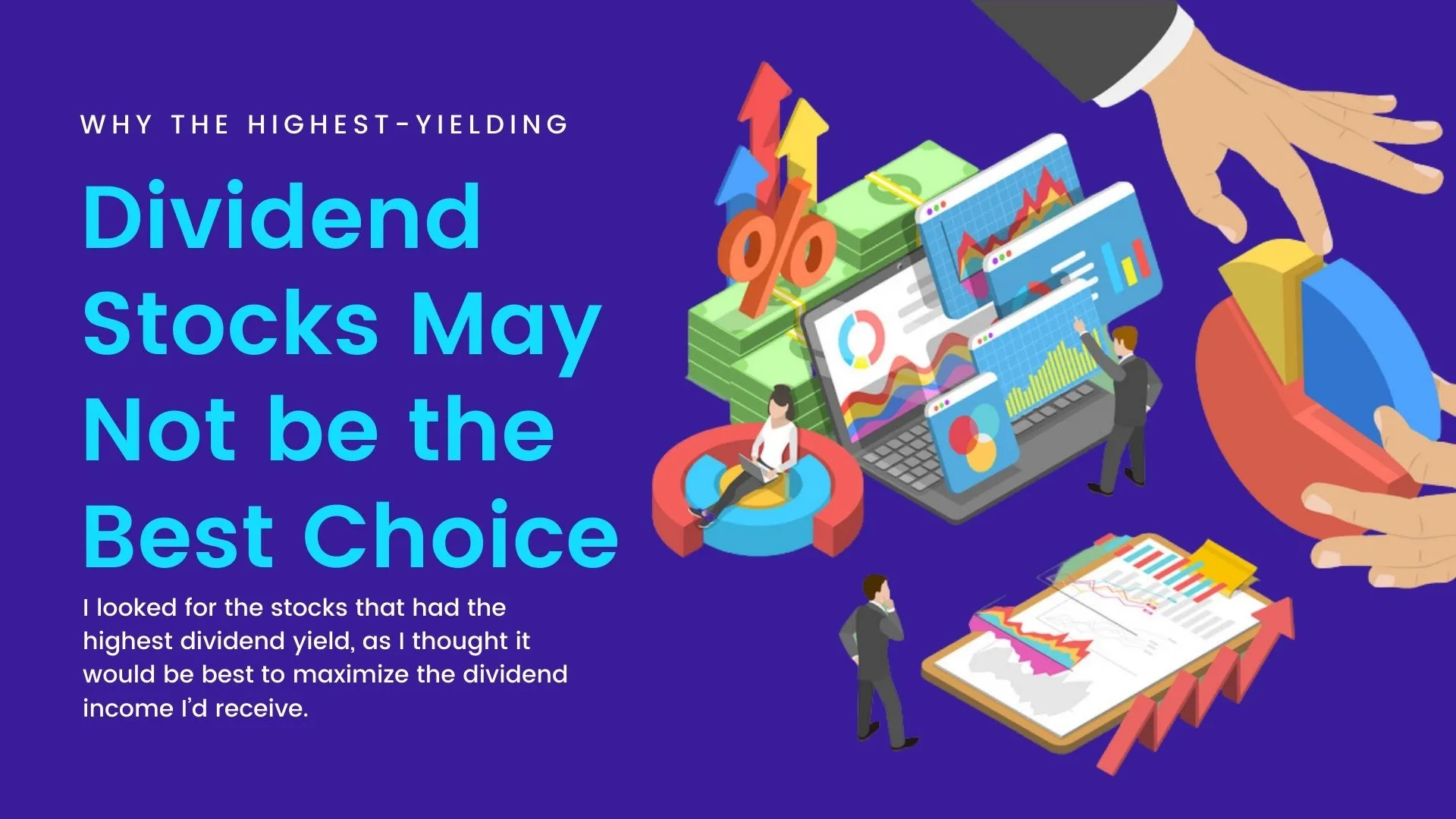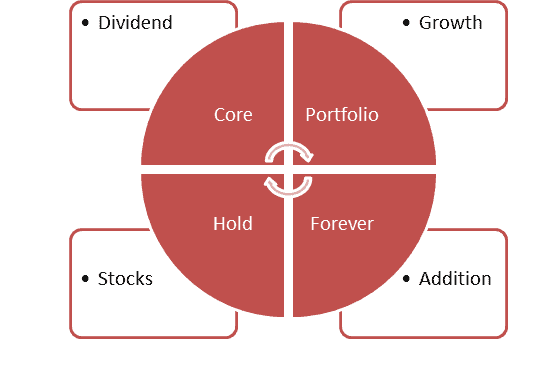Why the Highest-Yielding Dividend Stocks May Not be the Best Choice
When I first started learning about investing, I looked for the stocks that had the highest dividend yield, as I thought it would be best to maximize the dividend income I’d receive.
But as I’ve gained more experience, I’ve learned that this usually isn’t the best approach. In this post, I’ll explain why some high-yielding dividend stocks may be too good to be true, why we need to look beyond the dividend yield, and how to find the balance between dividend yield and dividend growth, depending on your investing goals.
What is Dividend Yield?
Before we look at potential issues with high-yield dividend stocks, let’s take a moment to define what dividend yield is and how it’s calculated.

Dividend yield is a percentage that measures the annual dividend payment of a stock compared with the current stock price. It’s calculated as follows:
Dividend yield = Annual Dividend / Current Price Per Share x 100
For example, if a stock is priced at $100 per share, and it pays $3 annually in dividends, then the dividend yield will be 3%:
Dividend yield
= Annual Dividend / Current Price Per Share x 100
= $3 / $100 x 100
= 3%
Some companies don’t pay dividends at all, in which case their dividend yield is effectively zero percent.
Fast-growing companies typically have a dividend yield between 0.5 and 2%, while companies with more moderate growth are typically in the 2-5% range. And anything above 5% would be considered a high-dividend yield.
For a dividend yield to increase, either the annual dividend amount needs to go up, or the price per share needs to go down.
Is a High-Yield Dividend Stock Too Good to be True?
High-yield dividend stocks are appealing, as it’s natural to want more income to be produced from our investments, rather than less. But if a stock has a dividend yield that’s well above 5%, we need to be particularly cautious.
In fact, the higher the dividend yield, the more likely it is that there’s something fundamentally wrong with the company, which ultimately puts the dividend at risk. And if the dividend gets cut, the share price will be reduced even further. So you not only lose the capital you’ve invested, but you’ve also lost the dividend.
Let’s illustrate a common scenario with an example:
- Suppose XYZ Corporation is trading for $50 per share, and paying $1.50 annually in dividends, for a dividend yield of 3%.
- In their quarterly earnings report, the CEO indicates that revenue and earnings are expected to decline by 20% in the next fiscal year.
- This causes investors to lose confidence in the company, so they sell their shares, and the price of the stock drops to just $20 per share.
- As a result, the dividend yield becomes 7.5% (remember that the dividend yield increases when the price per share drops).
So imagine you’re an investor, and you spot this sweet 7.5% dividend yield on XYZ Corporation. Without knowing what happened, you might be tempted to buy it so you can earn some of those dividends for yourself.
But any investor needs to look beyond the dividend yield, to understand if a stock is something they want to invest in. In this case, it wouldn’t take long to discover that revenue and earnings are set to decline and that this may put the dividend at risk. In fact, the company may cut the dividend altogether.
So at first glance, the 7.5% dividend seems appealing. But after digging deeper, you may discover that the dividend has a high risk of being reduced, or eliminated altogether.
What Other Factors Should Be Considered When Choosing a Stock?
There are many factors, above and beyond the dividend yield, that an investor should consider when choosing a stock to invest in. Here are a few to keep in mind:
- Payout Ratio: This measures the percentage of the company’s profits that get paid out as dividends. A payout ratio greater than 60% may indicate that the dividend is at a higher risk of being reduced if the company’s earnings decline.
- Dividend Growth: This measures how quickly the dividend payment is growing over time. Most investors look at the average dividend growth for the past 5 years. A healthy, dividend-paying company typically grows its dividend by at least 3% per year.
- Revenue Growth: This measures how quickly the company’s revenue is growing over time. Growing revenue is important, as it supports a growing dividend.
- Earnings Growth: This measures how quickly the company’s earnings are growing over time. Earnings growth also helps to support a growing dividend.
- Free Cash Flow Growth: This measures how quickly the company’s free cash flow is growing over time. This is important because cash, rather than earnings, is required to pay the dividend.
- Dividend Streak: This measures the number of years in which the company has consistently paid a dividend, and has increased it each year. The best companies have done this for twenty-five years or more, and are known as Dividend Aristocrats. Seeing a company maintain its dividend throughout the most recent recession is also a good sign.
- Debt-to-EBITDA Ratio: This takes the company’s total debt, and divides it by EBITDA (Earnings Before Interest, Taxes, Depreciation, and Amortization). This ratio tells us, based on the company’s current earnings, how many years it would take to pay off all of its debt. In general, if a company has a lot of debt, it is more likely to cut the dividend.
In addition to quantitative factors, an investor should also look at whether the company has competitive advantages that give it pricing power, whether they believe in the mission of the company, and whether they believe the company has strong prospects for future growth.
How to Find the Balance Between Dividend Yield and Growth
The other issue with high-yield dividend stocks is that they normally have slower-growing dividends and less potential for capital gains. So how does an investor choose between focusing on dividend yield, and focusing on dividend growth?
The answer depends on the situation and the goals of the investor. In most cases, investors fall into one of two categories:
- They are dependent on their dividend income to cover current living expenses.
- They are re-investing their dividends for future income needs.
Investors in the first category may want to target higher dividend yields, with less of a focus on dividend growth, so they maximize the amount of dividend income their portfolio generates now. Of course, they’ll want to ensure the dividend income they receive is relatively safe, by considering the factors discussed above. And these investors will also want to ensure that their dividends are growing at least as fast as inflation. This helps to cover cost-of-living increases in future years.
But investors that aren’t living off dividend income yet may want to focus more on dividend growth, rather than dividend yield. This allows the investor to take advantage of the compounding that happens over many years of continually reinvesting growing dividends. In fact, focusing on dividend growth rather than dividend yield can result in a big difference in dividend income over time.
Let’s take an example:
- Suppose two investors named Tom and Joe both start with a lump sum of $100,000 to invest and contribute an additional $2,000 to their investment account each month.
- They both plan to reinvest their dividends, and are not planning to retire for 30 years.
- Tom decides to focus on companies with an average dividend yield of 6%, and a dividend growth rate of 1%.
- Joe instead focuses on companies with an average dividend yield of 2.5%, and a dividend growth rate of 10%.
- Let’s assume that the stocks owned by both Tom and Joe appreciate at a rate of 5% per year (in all likelihood, Tom’s stocks would appreciate more slowly than Joe’s, but let’s keep the example simple).
Who do you think will generate the most income from dividends?

While Tom generates more dividend income than Joe for the first 10 years, by year 30, it’s no comparison. Joe’s focus on dividend growth results in an astounding $634,340 in dividend income a year! This is almost ten times more than Tom’s dividend income of $76,415.
In this post, we looked at potential issues associated with investing in the highest-yielding dividend stocks, and why it’s important to look at other factors beyond the dividend yield before deciding to invest in a stock.
We also explored the tradeoff between dividend yield and dividend growth, and how over time, focusing on dividend growth can generate more income than focusing on dividend yield alone.
Regardless of whether you choose to focus on dividend yield or dividend growth, be sure to speak with a registered investment advisor before making any investment decisions.
This article was written by Derek of Positively Passive Income, who enjoys sharing his knowledge of investing, and teaching others how they can become financially independent by earning passive income through dividends and selling options.





